| Pages:
1
2
3 |
densest
Hazard to Others
  
Posts: 359
Registered: 1-10-2005
Location: in the lehr
Member Is Offline
Mood: slowly warming to strain point
|
|
The only glyme I have is butyl diglyme. It dissolves a little potassium iodide. The pictures show 0.3g KI in 4ml butyl diglyme. I estimate that 1/3 to
1/2 of the solids dissolved, yielding the yellowish solution. I presume the color is from some form of iodide ion. I applied 19V to stainless steel
electrodes. No current was observed on the power supply meter, which reads in units of 10 mA. The power has been on for an hour. No visible change has
occurred.
Oh well. Use of a regular glyme (ethylene glycol dimethyl ether or a multi-glycol in the family) might give more ions.
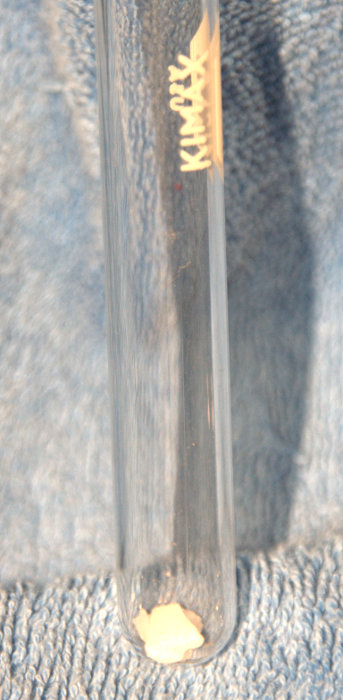 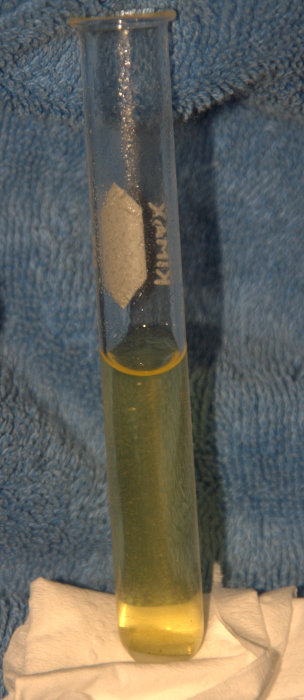 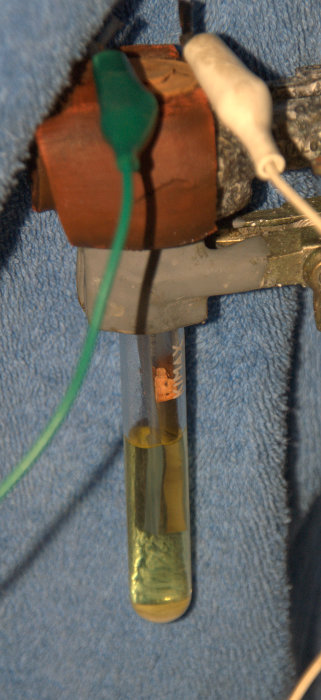 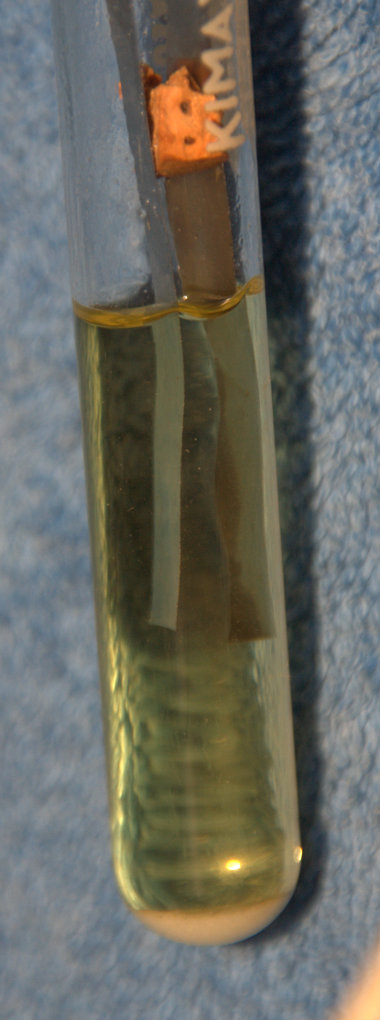
|
|
|
len1
National Hazard
   
Posts: 595
Registered: 1-3-2007
Member Is Offline
Mood: NZ 1 (goal) - Italy 1 (dive)
|
|
Quote: Originally posted by Nicodem  | Quote: Originally posted by len1  | | Maybe. But is it not mean to suggest people try something that you have no experience in. One should have more respect for other peoples time and
people in general, thats my suggestion to nicodem. |
Yes, I know, but this is such a contagious behaviour and I learned from the best. You could be proud and I should be ashamed.
|
I must be suffering from a routine attack of amnesia. Thank god this is a forum were everything we write is recorded. And you should have no trouble
at all reminding me were I suggested people try something I have no experience in. And you gain some brownie points in the process. If on the other
hand you cant, I gain brownie points and you lose all yours.
In regards to learning to be disrespectful from me - you flatter me needlessly. I have put people in their place where they sprout bullshit which they
really should know better of. Often these people use bullying tactics in front of this audience, who really dont know any better. So all of what you
call direspect really fits into that category.
Its a bit like the difference between kicking in old ladies, and stopping someone kicking in old ladies while hes in the act, with a few well placed
slaps.
[Edited on 13-8-2010 by len1]
|
|
|
Panache
International Hazard
    
Posts: 1290
Registered: 18-10-2007
Member Is Offline
Mood: Instead of being my deliverance, she had a resemblance to a Kat named Frankenstein
|
|
Quote: Originally posted by len1  | Quote: Originally posted by Nicodem  | Quote: Originally posted by len1  | | Maybe. But is it not mean to suggest people try something that you have no experience in. One should have more respect for other peoples time and
people in general, thats my suggestion to nicodem. |
Yes, I know, but this is such a contagious behaviour and I learned from the best. You could be proud and I should be ashamed.
|
I must be suffering from a routine attack of amnesia. Thank god this is a forum were everything we write is recorded. And you should have no trouble
at all reminding me were I suggested people try something I have no experience in. And you gain some brownie points in the process. If on the other
hand you cant, I gain brownie points and you lose all yours.
In regards to learning to be disrespectful from me - you flatter me needlessly. I have put people in their place where they sprout bullshit which they
really should know better of. Often these people use bullying tactics in front of this audience, who really dont know any better. So all of what you
call direspect really fits into that category.
Its a bit like the difference between kicking in old ladies, and stopping someone kicking in old ladies while hes in the act, with a few well placed
slaps.
[Edited on 13-8-2010 by len1] |
I know the air is thick with political crap here in australia atm, with a federal election soon, so i will not attribute this wholly piss-weak
unconvincing analogy as having come out of your unaffected mind len. i have however forwarded it to Fred Nile and Steve Fielding as i think they might
be able to use it in when they try to differentiate themselves from others.
As to the point to your current role, that of pointer outer of peoples inconsistencies, contradictions and short-comings, its unbecoming and
irrelevant to what the forums about. However you obviously feel some personal conviction presently regarding this mantra and i cannot counter sensibly
regarding it, rather than to say 'don't be hatin' man' and that prefacing or posthasteing(spl?) with 'this is not meant to offend' has its its limits
when your tone is curt, disrespectful or aggressive.
Disrespectfulness is revolting and unnecessary and right up there with intolerance. This is 2010 and if we have something to say we surely can
communicate it nicely, like a cutie grandmother baking pies.
In response to anything you have to say to this input, i agree, wholeheartly, and i was wrong.
|
|
|
blogfast25
International Hazard
    
Posts: 10562
Registered: 3-2-2008
Location: Neverland
Member Is Offline
Mood: No Mood
|
|
densest's 'failed' experiment must surely mean that KI doesn't dissociate in butyl diglyme?
|
|
|
watson.fawkes
International Hazard
    
Posts: 2793
Registered: 16-8-2008
Member Is Offline
Mood: No Mood
|
|
Not necessarily.
It's also conceivable that it's exhibiting diode behavior. If no current flows in the opposite direction, that's better evidence. But if KI is
dissolving and not dissociating, there's an open question about how it's solvating.
|
|
|
ScienceSquirrel
International Hazard
    
Posts: 1863
Registered: 18-6-2008
Location: Brittany
Member Is Offline
Mood: Dogs are pets but cats are little furry humans with four feet and self determination! 
|
|
I think it is highly likely that the potassium iodide is in the form of ion pairs, it has dissolved but the two ions are so closely bound together
that the solution is effectively non conducting.
This is a known phenomenon in methanol, acetone, etc.
http://actachemscand.dk/pdf/acta_vol_23_p3120-3124.pdf
|
|
|
Nicodem
Super Moderator
      
Posts: 4230
Registered: 28-12-2004
Member Is Offline
Mood: No Mood
|
|
I don't have much equipment and glassware for electrochemical experiments, so the best I could do was to kind of repeat Densest's experiment by using
a saturated solution of KI in diglyme instead. I added 250 mg of KI and 6 ml of diglyme with a stir bar in a test tube, closed with a septum, heated a
bit while stirring and purging with argon. Left stirring for 1 h to make sure the solution was saturated with KI (most dissolved rapidly while some
remained undissolved, so I guess the goal was achieved). The solution was of the same yellow colour as on the pictures above. The stirring was then
turned off.
I then inserted two long standard medicine/lab needles (didn't have any electrodes so I used these, they should be made of inox, I think) and
connected to a lab power supply set at 12 V. At this potential there immediately started to form a dark brown-red colour around the anode. This was a
solution heavier than the electrolyte (rapidly sinking to the bottom and accumulating there). At the anode there started forming bubbles (I used
diglyme straight from the bottle, so it was not anhydrous). After some 3 min the bubbling slowly subsided and more and more of some grey-blue fluffy
stuff begun forming and after enough formed it separated from the electrode and vent to the top (either it is easier than diglyme solution or it is
carried by tiny bubbles). The current was 600 mA so there is no problem with conductivity (this is a huge current considering the thin electrodes
used!). I checked the potentials of the electrodes against a reference electrode (a third needle inserted trough the septum) and for the anode it was
4 V and for the cathode it was 7 V. So the cathode seems much more polarized.
Unfortunately I have no camera in the lab, but it is an interesting sight. After 15 min there is less and less bubbles forming, the upper part of the
solution is filled with a fluffy grey-blue stuff which show the morphology of tiny needle like crystals that reflect light as they turn float and turn
around. The lower part is full of brown-red solution. I will take a camera with me next time and document it from the start. After disconnecting the
electricity the whole thing is still relatively "alive". Bubbles keep on forming and the grey-blue tiny needles keep on moving up and down, apparently
reacting when in contact to the brown-red denser solution. I turned on the stirring and after 5 min the grey-blue stuff disapeared completely (except
for the few "microcrystals" that adhered to the glass above the level of the solution). The solution remained still a bit brown-red though.
I will not make any claims as for the nature of the formed stuff, but their appearance and behaviour is consistent with the expected elements.
Potassium is known to be slightly soluble in diglyme by electron solvation by forming a pale blue solution (kind of like alkali metals in NH3, just
way less soluble), so the bluish colour can be explained by this. It is also slightly less dense than diglyme so it should float on top. The brown-red
colour is consistent with the colour of the expected triiodide, though I don't know why would this be denser than the starting electrolyte. All in all
it is an interesting experiments and it wasn't a waste of time (though my boss would certainly not agree given that I neglected my work). If nothing
else, it would be an interesting show for the children as a demonstration of electricity causing "colours and stuff". I recommend anyone who can, to
try it out. Though this setup is useless for preparative formation of potassium, if that is potassium at all. A cell with separated electrodes should
be used. After 15 min the upper half and the lower half were filled with the respective products which thus came in contact.
PS: Densest, is that "butyl glyme" meant to be diethylene glycol dibutyl ether or just ethylene glycol dibutyl ether? (BuOCH2CH2)2O or (BuOCH2)2? If
it was (BuOCH2CH2)2O then I'm surprised it gave a non-conductive solution while if it was (BuOCH2)2 it surprises me than any KI dissolved at all. And
BTW, without your experiment I would not be motivated to check this out. 
Edit: I checked at which potential does the solution start conducting. Up to 4 V it is zero current. At 4.15 V the current jumps from 0 mA to 20 mA,
while at 7 V it is already about 200 mA. But this was done after 15 min electrolysis and stirred everything up, so it is not a very reliable data.
[Edited on 13/8/2010 by Nicodem]
|
|
|
densest
Hazard to Others
  
Posts: 359
Registered: 1-10-2005
Location: in the lehr
Member Is Offline
Mood: slowly warming to strain point
|
|
@nicodem - verrrry interesting! I have dibutyl diglyme (the stuff that collects AuCl4- & various other ions). There seem to be all sorts of
interesting & non-intuitive things going on in polyethers + iodides. I found http://dx.doi.org/10.1016/S0277-5387(00)87147-8 this randomly:
| Quote: | Crystal structure of sodium iodide·(diglyme): An unprecedented bridging role for diglyme
The diglyme adduct of sodium iodide, NaI·(CH3OCH2CH2)2O, has been structurally characterized by X-ray diffraction. It forms infinite zig-zag chains
which, unlike most complexes of the salt, retain Na---I bonds. In addition, diglyme molecules bridge pairs of Na atoms through four-co-ordinate O
atoms, so representing a new role for this neutral oxygen donor. |
So different glymes could easily dissolve KI in quite different ways, it looks like!
I thought of trying cyclohexanone or DMSO, but it looks like either one would react with an alkali metal. It would be work to prepare diglyme from
CH3-O-CH2-CH2-OH which I have here. I'd have to look up the synthesis - dehydration with hot H2SO4 like diethyl ether probably won't work.
One thought about why my experiment showed essentially zero conductivity while yours showed large conductivity: water. DBDG is close to immiscible
with water & I used reagent grade material from a closed bottle. Diglyme is much more friendly to water. Would a little water encourage
disassociation of the KI in diglyme?
The electrodes were stainless steel - 321 alloy, IIRC - foil used to wrap metal parts for heat treatment in ovens. They're quite conductive and were
cut from the same sheet. I doubt there was enough asymmetry to cause a diode action.
[Edited on 13-8-2010 by densest]
|
|
|
watson.fawkes
International Hazard
    
Posts: 2793
Registered: 16-8-2008
Member Is Offline
Mood: No Mood
|
|
Quote: Originally posted by densest  | | The electrodes were stainless steel - 321 alloy, IIRC - foil used to wrap metal parts for heat treatment in ovens. They're quite conductive and were
cut from the same sheet. I doubt there was enough asymmetry to cause a diode action. |
I mentioned diode
action on purely formal grounds, to avoid prematurely precluding a possibility. If there is diode action, I'd expect it to be more related to the
solvent and electrolytes than to the electrode material. I can imagine a kind of electrically-induced temporary polymerization of a glyme-family
solvent which could have a higher-than-typical polarization voltage. (I'm thinking it would share something in common with liquid crystals, though not
sure just how.) I did think that 17 V was pretty high to still exhibit diode action, so I didn't put much weight on it. Subsequent discussion has me
more interested in the possibility than when I first suggested it.
|
|
|
len1
National Hazard
   
Posts: 595
Registered: 1-3-2007
Member Is Offline
Mood: NZ 1 (goal) - Italy 1 (dive)
|
|
First, nicodem has lost all his brownie points, as per my previous post. But he has gained some because for one of the few times in living memory he
has actually tried what he suggested.
Indeed who am I to point out peoples inconsistencies - you should all be free to be inconsistent as you like - and if I may say many do a damn good
job at it.
Alas Nico is not, as usual, being fully clear and transparent in leaving open the possibility that he made potassium because he hasnt told us how he
dropped his 'potassium stuff' into water and got a bang. Regarding the analogy to NH3 - diglyme is an ether, and anyone whose ever dried ether with
alkali metals knows how soluble these are in them.
Like sciencesquirel says the dissolution of KI in glyme is covalent, there is no ionization because diglyme molecules being non-polar can not
stabilize solved ions. somewhat similar to sugar in water. such solutions dont conduct electricity.
But ethers also tend to be wet and hydroscopic. the water in them will ionize some KI molecules. so i believe the reason for the conductivity here
is the presence of water, as densest says.
And what happens when you electrolyze aqueous KI? You get I2 and KOH. The former gives yoy the purple solution in diglyme, the later KOH solution
badly soluble in ether, and so an emulsion. So we get pretty much what was expected. But this has nothing to do with making potassium
[Edited on 13-8-2010 by len1]
|
|
|
DerAlte
National Hazard
   
Posts: 779
Registered: 14-5-2007
Location: Erehwon
Member Is Offline
Mood: Disgusted
|
|
Blogfast25 wrote:
| Quote: | | Precisely what can reduce what depends enormously on circumstances: the reduction potentials (in solution) are a poor guide for determining this
|
WRT the reaction of the alkali metals with water, I haven’t seen Rb or Cs perform but there is a gradual increase in intensity with atomic weight.
Several factors are obviously involved.
Reactivity, reckoned by SEP, has Li the winner with 3.04v., followed by Cs @3.03v., Rb @ 2.98v, K@ 2.93v, Na, 2.71v. However, the order of heat of
formation of XOH, in J/mol, is: Na>K>Li>Rb>Cs although the difference is small. In terms of J/g, however, Li wins hands down, because of
its low atomic weight.
Melting points are Li, 181C, Na 98C; K 63C; Rb, 39C; and Cs, 28C; BP’s vary from 1342C for Li down to 671C for Cs. Cs is essentially liquid at RT.
The latent heat of fusions are all low, ~ 3KJ/mol.
Density (g/cc): Li, 0.53; Na 0.97; K, 0.89; Rb, 1.53; and Cs, 1.93.
{K has an anomalously large atom; in fact all K salts have a lower density than Na salts. Li salts are correspondingly relatively heavy due to the
small atomic size.} Heat capacity (J/molK); Li, 24.8; Na, 28.2; K, 29.6; Rb, 31.1 , Cs, 32,2.
Heat conductivity (w/cmK); Li, 0.847; Na, 1.41; K, 1.02; Rb, 0.582 , Cs, 0.359. – here Li seems anomalous. (All data CRC)
From the SEP data it might seem that Li would be the most active. With water, in my experience it is the least. A small piece dropped into water does
react very quickly, melts immediately and flies around on the surface like the proverbial blue-arsed fly. The hydrogen does not ignite, nor is there
any of the same (metal vapor?) smell that Na gives off.
Na is more active but does not ignite the H2 unless it touches the side of the vessel, when sometimes a yellow spark can be produced; hot water
sometimes lets it ignite. Na & K usually give off a final spit, possibly due to solution of very hot hydroxide.
K is noticeably more active; the hydrogen ignites with a blue flame due to K vapor.
Has anyone here seen Rb or Cs react with water, as an eyewitness? (None of the crap from youtube or media sources, please; see
Blogfast, above!). I wonder whether Cs is heavy enough to sink or is buoyed up by the hydrogen. Rb I would expect to be like K.
If a piece of Li is ignited it burns about as fiercely as Mg. {Na and K I cannot remember, it has been too long ago.} The heat of combustion is
greatest for lithium (in J/mol), least for Rb in order Li>Na>K>Cs>Rb. The chlorides, however, have a heat of formation in order of AW, Li
least.
Thus SEP is not a sure guide for reactivity. The numbers seem to suggest that Cs is not as reactive as the elementary text books often tout.
Der Alte
|
|
|
Nicodem
Super Moderator
      
Posts: 4230
Registered: 28-12-2004
Member Is Offline
Mood: No Mood
|
|
Well yes, that is expected, but I find it extreme that in butyl diglyme the solution would conduct <10 mA at 19 V while in diglyme it conducts 600
mA at 12 V in a similar setup. In diglyme is about as much current as one gets with a similar aqueous solution. Though, it could be that a combination
of much lower solubility in butyl diglyme, its way lower dipole moment, the disrupting properties of the butyl groups, etc., all together combine into
something like more than two magnitudes lower conduction/dissociation. It is possible, but still I find it surprising. How about if you check the
conductivity of KI in your methyl celosolve? OK, it would only form the alkoxide at the cathode, but just out of curiosity.
| Quote: | | One thought about why my experiment showed essentially zero conductivity while yours showed large conductivity: water. DBDG is close to immiscible
with water & I used reagent grade material from a closed bottle. Diglyme is much more friendly to water. Would a little water encourage
disassociation of the KI in diglyme? |
My bottle of diglyme is a nearly full 2.5L from Alfa***r, and I'm more or less the only one in the lab who uses it and I take care of not
contaminating it with moisture. So the H2O in there is mostly the one that is originally present there. It would take a lot of abuse to contaminate it
with enough moisture to allow for a ratio with KI needed for substantial ion solvation. Besides, diglyme solvates potassium ions very efficiently and
it would compete with water. The KI used also could had brought in some moisture as I only heated it with a heat gun in the test tube for a few
minutes before adding the solvent. I did not dry it in an oven. But all in all there must have been only little water present because the formation of
the putative hydrogen slowly subsided after the first few minutes of electrolysis. The water present around the electrode must have been consumed. The
"microcrystals" of the putative potassium that floated around, however, did slowly kept on forming tiny bubbles, so the bulk of the solvent distant
from the electrodes obviously was moist to some degree. Next time I try this I will distil the diglyme from CaH2 first.
Quote: Originally posted by len1  | | First, nicodem has lost all his brownie points, as per my previous post. But he has gained some because for one of the few times in living memory he
has actually tried what he suggested. |
Spare us that narcissistic crap, will you? It is even more pathetic than your previous vigilante disclaimer. I always try my ideas experimentally.
That’s how I make my living. Though, I do wish I had technicians working for me, but I don’t. Yet, when someone else asks for help for his own
interests, I will most certainly not waste my time performing experiments just to give a suggestion on how to solve his/her problem. (unless
I’m paid for the inconvenience, but that is understood)
| Quote: | | Alas Nico is not, as usual, being fully clear and transparent in leaving open the possibility that he made potassium because he hasnt told us how he
dropped his 'potassium stuff' into water and got a bang. Regarding the analogy to NH3 - diglyme is an ether, and anyone whose ever dried ether with
alkali metals knows how soluble these are in them. |
I already said that I do not have the equipment to do a preparative electrolysis and I’m certainly not going to build an electrolytic cell just for
your pleasure. And by the way, I understand that you are not a chemist and that you neither know or apparently don’t want to know much about
chemical interactions, mechanisms, solvation, solvents properties and other things chemists consider basics, but you could at least do as a favor and
stop spreading nonsense. At least I admit I don't know much about non-chemistry and don't go around on non-chemistry forums claiming things out of my
field. Diglyme is not just any ether! It solvates potassium cations extremely efficiently and the solutions are ionic and conductive. Check the
literature. Potassium and sodium metals dissolve in glyme, diglyme and polyglymes in the range from micro up to milimolar solutions. A pale
blue solution is formed. Check the literature. Potassium hydroxide does not bubble gas just because the solvent is not totally anhydrous and it does
not float on diglyme, but potassium metal does. Check the literature. Potassium hydroxide also does not have a metallic shine and in such small
amounts it dissolves in diglyme. And so on…
You are always such a big disappointment. I seriously thought you had done a literature search on the subject and have some backing for your claim
that potassium can’t be electrolyzed in diglyme. I seriously expected you to give an explanation on what makes lithium so easily electrolyzable and
supposedly potassium impossible. I seriously expected some serious scientific discussion. Yet, all you had to say was that it is impossible and give
some absurd reasons, like if it would be possible it would have been done (without even checking the literature!). Great! So we can just stop
experimenting. Everything that could be done was already done and everything that was not done does not work. Just don’t tell that to my employer or
else every researcher in my institution will become unemployed.
I have plenty of glyme and diglyme, but I don’t have any triglyme and tetraglyme. Could you subsidise me 0.25 L of each of those two? If nothing
else, just to complete my collection of solvents.
…there is a human touch of the cultist “believer” in every theorist that he must struggle against as being
unworthy of the scientist. Some of the greatest men of science have publicly repudiated a theory which earlier they hotly defended. In this lies their
scientific temper, not in the scientific defense of the theory. - Weston La Barre (Ghost Dance, 1972)
Read the The ScienceMadness Guidelines!
|
|
|
Eclectic
National Hazard
   
Posts: 899
Registered: 14-11-2004
Member Is Offline
Mood: Obsessive
|
|
Does anyone have some propylene carbonate to try this with? It IS after all used in lithium batteries as electrolyte.
|
|
|
blogfast25
International Hazard
    
Posts: 10562
Registered: 3-2-2008
Location: Neverland
Member Is Offline
Mood: No Mood
|
|
Quote: Originally posted by Eclectic  | | Does anyone have some propylene carbonate to try this with? It IS after all used in lithium batteries as electrolyte. |
Nice point!
|
|
|
len1
National Hazard
   
Posts: 595
Registered: 1-3-2007
Member Is Offline
Mood: NZ 1 (goal) - Italy 1 (dive)
|
|
Great rant ... now show us the potassium
|
|
|
Jor
National Hazard
   
Posts: 950
Registered: 21-11-2007
Member Is Offline
Mood: No Mood
|
|
I find it weird that some people here are accusing Nicodem of not trying an experiment?
First of all, he does so sometimes, like here, and here:
http://www.sciencemadness.org/talk/viewthread.php?tid=11706
And I have seen a few more occasions.
He does great contributions to this forum, always gives very useful imformation and references, etc. He doesn't have to reply to a topic... And when
he does I find it weird to accuse him of not trying anything.
But anyway, it seems that those crystals were indeed potassium. Maybe you should have picked some out with a pair of tweezers and add them to water,
but that's to late now 
I have seen a reaction on YouTube where some heats magnesium powder with sodium hydroxide, wich gives some very impure material but it reacts very
vigorously with water, and ignites. I wonder if this works with potassium. I don't have any Mg powder, so I can't try. The problem is that HOH always
contains 15% water, so maybe some other salt (carbonate or chloride maybe?) should be used. But I think the K would simply boil away at the
temperatures involved.
[Edited on 14-8-2010 by Jor]
[Edited on 14-8-2010 by Jor]
|
|
|
watson.fawkes
International Hazard
    
Posts: 2793
Registered: 16-8-2008
Member Is Offline
Mood: No Mood
|
|
You should learn what modal logic is. You are repeatedly and
demonstrably capable of condescension; let's see if you can take it as well as you dish it out. So here's my condescension to you: Wikipedia, Modal logic, since you don't seem to want to look at references, relying up your god-like breadth of experience.
Nicodem did not claim he had potassium. What he claimed is that it was plausible that he had potassium.
Quote: Originally posted by Nicodem  | | The "microcrystals" of the putative potassium that floated around, however, did slowly kept on forming tiny bubbles |
Note the word "putative", which means "this is my current hypothesis", not "this is what it is". Modally, he's expressing
possibility (in addition to likelihood). The modal opposite of possibility is impossibility, not counterfactuality. Your critique that he hasn't
conclusively demonstrated potassium is pointless, because he did not claim that. Previously, you offered an alternate model of what was happening.
Such an alternate is of the same hypothetical status as the hypothesis of observed potassium, that it's a different possibility. Now the existence of
an alternate possibility does not cause the original statement of possibility to become impossible; that's just not a valid modal deduction. For one,
it's symmetric; if this were the case, Nicodem's assertion of possibility would deny the possibility of your assertion of possibility.
So, from a purely logical point of view, len1, you're full of shit.
Nicodem, however, has identified the psychological element at play here: your narcissism. The salient characteristic of narcissism is the devalue of
the internal state of others. In the present case that's the devaluing of another's assertion of possibility. Denying these, you seem to believe that
only your own conception of possibility stands. The external manifestation of this is a breathtaking disrespect for others.
I'll freely admit that I have moved from logical argument to ad hominem attack. That's because I have two purposes for you, len1: (1) to show
your logical absurdity and (2) to stop your abusive behavior. Logical argument suffices for the first, but not for the second.
len1, you are only less abusive here than Sauron was because you post less. Let's examine your pattern of behavior in the present thread. Here's your
first outburst in this thread, concurrent with your first post: You start by claiming that Nicodem
shouldn't be offering advice he's not willing to take himself. That might have been a fair critique, had it been grounded in reality. After that, you
make an additional argument about implausibility: Quote: Originally posted by len1  | | If potassium could really be obtained this way dont you think it would be well known by now? A high school experiment |
So you've immediately shifted your position to "it can't work because no one else has made it work yet", an attitude about the past
that, taken to an extreme, stifled scientific research for centuries. You next, after repeating your condemnation of lack of experiment, add to all
this some self-aggrandizement as justification for your behavior: Quote: Originally posted by len1  | | Its a bit like the difference between kicking in old ladies, and stopping someone kicking in old ladies while hes in the act, with a few well placed
slaps. |
I'll elide an argument that this is pure Freudian projection. After that one, after Nicodem actually
performed an experiment, you then, after making an acknowledgment that is pointedly not an apology, have to change tactics and claim that he's a bad
experimenter: Quote: Originally posted by len1  | | Alas Nico is not, as usual, being fully clear and transparent in leaving open the possibility that he made potassium because he hasnt told us how he
dropped his 'potassium stuff' into water and got a bang. |
As I've argued above, you didn't deny what he was
actually claiming, instead poking at a straw man and in any case making the point that Nicodem is at fault rather than the experiment being
incomplete. All of which brings us back full circle: Now let me summarize:You start with a
challenge against one of the most competent people here. I can only surmise that your own insecurity induces you to play "king of the hill".
You then augment the challenge with an insult that Nicodem is stupid for even trying—no matter that the insult is grounded in a
delusion about the completeness of science. Also, "Inconceivable!".
You justify your own bad behavior with the ridiculous claim that you're a white knight. It's ridiculous because I, indeed, did laugh at you when
I saw that.
After the challenge is met, you proceed with an off-topic insult and a straw man.
Finally, lacking anything else to say, you reiterate your straw man. len1, your behavior here has nothing to do with science and everything
to do with emotional abuse. If this were the first such incident, I wouldn't have said anything. I said very little about the recent incident where
you chased off the newcomer (him with experimental results about electrolysis of NaOH) with similar kind of abusive treatment. Recently, your behavior
has been a net detriment to this discussion board.
[Stage Whisper: len1 will respond by deflecting everything about him that's contained herein and pick up on something else I've said elsewhere in this
forum, attempting to attack the messenger.]
|
|
|
peach
Bon Vivant
    
Posts: 1428
Registered: 14-11-2008
Member Is Offline
Mood: No Mood
|
|
| Quote: |
I must be suffering from a routine attack of amnesia. Thank god this is a forum were everything we write is recorded. And you should have no trouble
at all reminding me were I suggested people try something I have no experience in. And you gain some brownie points in the process. If on the other
hand you cant, I gain brownie points and you lose all yours. |
[edit]Having read some of the arguing going on, I should point out, I'm not attempting to 'take sides' or in anyway agree or disagree with the
experiment it's self here, I just...[/edit]
...actually laughed reading that.
On BMX forums they'll have a "yeah... he's kewl!" or a "he's a f00l!" style button to rate posts.
We need one. "pawned", "pawner". Although, I expect stoned BMX'ers would probably be more reasonable in their choice of clicks than we'd find in some
of the highly charged debates here; ironically enough.
Maybe add another for "cooking" with a chef's hat reward badge for over 10 clicks, and Michelin stars for the leading professionals.
| Quote: |
Its a bit like the difference between kicking in old ladies, and stopping someone kicking in old ladies while hes in the act, with a few well placed
slaps. |
Yep, people often mix the two up it seems.
One night, being the kind of weirdo awake at 4am sat in silence reading this forum, I heard some guy out in the road being kicked around the floor and
begging for them to stop. It went on for a while, too long. He got back up, walked off, and was shouting again not long after.
No one else in the road was going out, despite a number of them having a few adult guys living in each house, so I armed up the baseball bat and went
investigating, hiding behind a car so they wouldn't see me. I was watching from a far to a.) provide evidence, b.) step in should it go beyond a mere
bitch slapping, where upon I would resolve the situation (which I am legally entitled to do at that point), c.) preferably not get seen or in anyway
involved, d.) not get knifed again.
It never came to that. Another guy finally came out to help and I threw the bat back into the garden. His panic stricken wife still reported me to the
police for standing there with the bat when she came out. Sure she'd have a slightly different opinion if that was her son on the pavement.
BACK TO THE TOPIC AT HAND
Don't know if this is the video you're discussing, but here's some (supposedly) cesium going into a water bath. Poor bath, poor cesium
And this, if it's genuine (which I suspect it is based on the subsequent mini pops) it's the best sodium example I've seen
That hurts seeing so much useful metal 'going in the bin'.
Whatever len1 has been up to in this thread, and I don't specifically watch out for his posts or know what his general attitude is like, I was very
impressed with his sodium thread.
| Quote: |
Note the word "putative", which means "this is my current hypothesis", not "this is what it is". Modally, he's expressing possibility (in addition to
likelihood). The modal opposite of possibility is impossibility, not counterfactuality.
[snip] |
I'll give you one "yeah... he's kewl!" point if you come over to my AlCl3 in DCM thread and copypasta that entire reply, for the benefit of entropy
and blogfast.
erm... John (my new name, I should try registering a supplier account with that)
[Edited on 14-8-2010 by peach]
|
|
|
turd
National Hazard
   
Posts: 800
Registered: 5-3-2006
Member Is Offline
Mood: No Mood
|
|
Quote: Originally posted by peach  | | Maybe add another for "cooking" with a chef's hat reward badge for over 10 clicks, and Michelin stars for the leading professionals.
|
Huh?? Cooking? Chef? Are you talking about me???  Actually I'd enjoy getting
points for blatant cookery. Actually I'd enjoy getting
points for blatant cookery.
But the cool/not-cool rating by users is one of the worst things that can happen to a forum. Then you'll have those "I rate all your posts you down,
because you rated me down"-sprees of certain psychos. And the worst thing: there will be endless and repeated meta-discussions on the subject: "You're
a down-rater!", "No, you're a down-rater!", blah blah blah.
Horrible, please just say no to anonymous rating of postings.
|
|
|
peach
Bon Vivant
    
Posts: 1428
Registered: 14-11-2008
Member Is Offline
Mood: No Mood
|
|
You're right thinking about it, particularly here, "you're a noob" "no, your a noob" "no, you're a noob" "did anyone run this?" "gtfo noob" "no,
you're a noob...."
I like the blatant cookery remark. 
|
|
|
densest
Hazard to Others
  
Posts: 359
Registered: 1-10-2005
Location: in the lehr
Member Is Offline
Mood: slowly warming to strain point
|
|
I couldn't find my cellosolve (ethylene glycol methyl ether) but I could find some butyl cellosolve (ethylene glycol butyl ether) so I took the same
test tube, electrodes, and the residual crystals in the test tube to perform another test. I sanded the electrodes with a diamond stone attempting to
remove any insulating layer.
The solution started out a very dark brown. Using the same power supply as before, 17V gave a .02A reading. 12V gave a .01A reading. If the electrodes
touched, the supply current-limited at maximum so the electrode surfaces are conductive. Bubbles (presumably H2) came from the negative electrode.
After an hour or so of electrolysis the picture shows the area around the electrodes is nearly clear - about the same color as the dibutyl diglyme
solution. Before the second picture was taken the electrodes were disturbed. The division between the clear and dark layers was much more distinct. A
whitish precipitate came from the negative electrode and a dark brown precipitate came from the positive electrode. The electrodes were repositioned
and run for another hour. The third picture shows the brown material on the positive electrode. It was not easily feasible to photograph the negative
electrode.
My guess is that the geometry, charge distribution, etc. of butyl ethers is not useful to solvate KI. I will see if I can get some diglyme or triglyme
for a reasonable price; I'm not optimistic. Any private donations of material or money gratefully accepted. My source for cheap methyl cellosolve
seems to have dried up.
The ugly lump between the electrodes is a piece of cork to prevent them from clinging together and shorting.
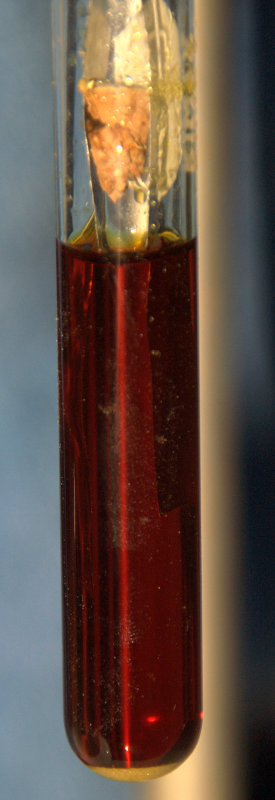 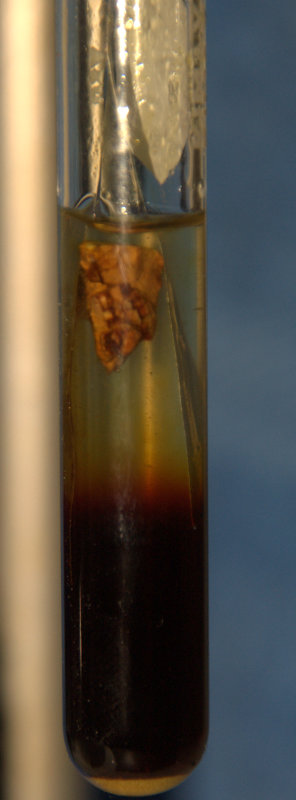 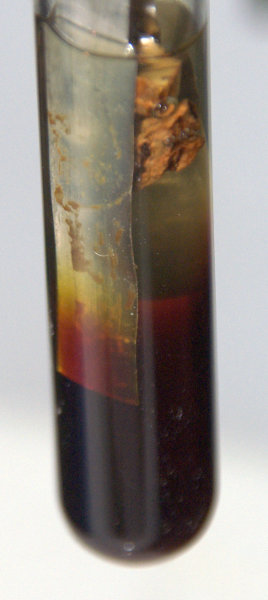
[Edited on 15-8-2010 by densest]
|
|
|
blogfast25
International Hazard
    
Posts: 10562
Registered: 3-2-2008
Location: Neverland
Member Is Offline
Mood: No Mood
|
|
In your dreams, matey. Turd is completely right.
It doesn't surprise me that you want to suggest this: the endless verbosity of your 'posts', replete even with a photo of your last dogs dinner seem
to indicate you believe life's a popularity contest.
... "for the benefit of entropy and blogfast".
Listen son, Nicodem here presented plausible arguments as to why electrolysis of a potassium salt in glyme may be possible. He followed up with an
experiment and made some putative claims.
You on the other hand make colourful and stinky messes based on very unrealistic hypotheses and then report by means of confusing and verbose novellas
that make it hard to make out the interesting stuff from your dietary habits.
You also took great pleasure in being taken for a 'lady', only later to come clean you were an ordinary John.
You also threatened to contact a moderator, behaviour that amounts to an attempt at bullying (good luck trying that with me!)
It's rather a shame that the moniker 'Turd' is already taken: it would suit you much better than 'Peach'. There's nothing peachy about you.
|
|
|
Eclectic
National Hazard
   
Posts: 899
Registered: 14-11-2004
Member Is Offline
Mood: Obsessive
|
|
Jeez, guys! Back to the topic?
Propylene carbonate, anyone?
|
|
|
watson.fawkes
International Hazard
    
Posts: 2793
Registered: 16-8-2008
Member Is Offline
Mood: No Mood
|
|
Quote: Originally posted by densest  | | My guess is that the geometry, charge distribution, etc. of butyl ethers is not useful to solvate KI. I will see if I can get some diglyme or triglyme
for a reasonable price; I'm not optimistic. |
The affinity of 18-crown-6 ether for potassium seems analogous here. The OCCO chain seems to fit the radius of the potassium ion well, while
OC<sub>n</sub>O doesn't work so well when n≥3.
|
|
|
densest
Hazard to Others
  
Posts: 359
Registered: 1-10-2005
Location: in the lehr
Member Is Offline
Mood: slowly warming to strain point
|
|
As a confirmation that the low conductivity I'm measuring with butyl ethers is valid, I ran some deionized water with about 1% H2SO4 in the test tube
cell. The conductivity was quite high. At 4V it passed 0.42A, and at higher voltages much more - the dynamic resistance was around 2 ohms.
|
|
|
| Pages:
1
2
3 |
|